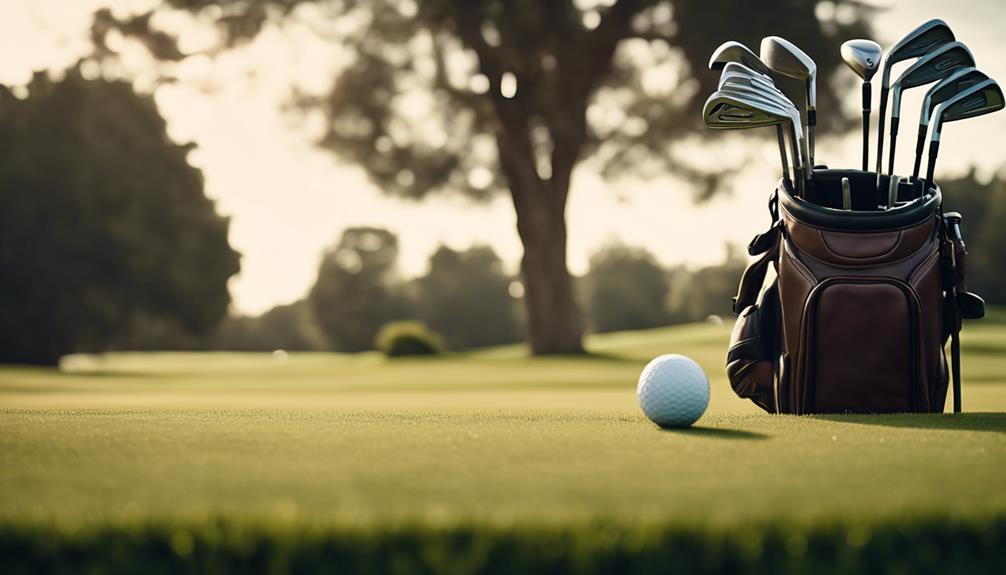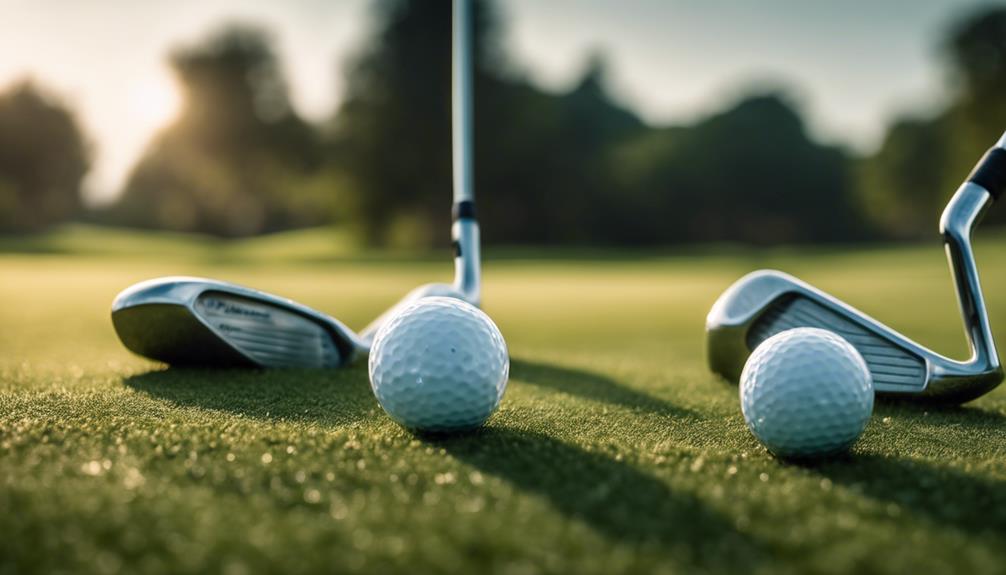- 7 Top Flite Golf Clubs XL for Improved Performance - September 28, 2024
- Top Flite Golf Clubs: Top 5 Reasons to Choose Them - September 28, 2024
- Top 3 Golf Club Fitters for a Perfect Swing - September 28, 2024
When getting back into golf, you'll want to focus on forgiving irons that offer a larger sweet spot and more leniency on off-center hits, allowing you to build confidence and improve your overall game quickly. Consider Sub70 and 699 irons, which provide exceptional forgiveness and playability at affordable prices. Don't forget about club fitting, which is essential to tap into the full performance potential of your irons. With these tools, you'll be well on your way to regaining your swing rhythm and improving your handicap. Now, discover how to take your game to the next level with the right club set and techniques.
Key Takeaways
- Forgiving irons with larger sweet spots, such as Sub70 and 699, offer more leniency on off-center hits for consistent results.
- Hybrids can replace long irons, providing even more forgiveness, and are priced around $130.
- Club fitting is vital to tap into the full performance potential of forgiving irons, considering shaft flex, lie, and loft.
- Custom build options allow for tailoring irons to unique swing styles by choosing shafts, grips, and lofts.
- Tour Edge's 30-day trial period for new irons enables trying them out risk-free, and investing in lessons can help get comfortable with new clubs.
Forgiving Irons for Confidence
When returning to the game, investing in forgiving irons can be a crucial step in rebuilding your confidence, as they offer a larger sweet spot and more leniency on off-center hits.
This means you'll enjoy more consistent results, even when you don't hit the ball perfectly. Game improvement irons, in particular, are designed to help you build confidence and improve your overall game.
They're perfect for returning players who want to get back into the swing of things quickly.
The Sub70 and 699 irons are excellent options to explore. Not only do they offer exceptional forgiveness, but they're also highly playable and affordable, with price ranges of around $500 and $560, respectively.
Additionally, you may want to examine adding hybrids to your set, which can replace long irons and provide even more forgiveness.
Priced at around $130, they're a great value for the confidence boost they can provide.
Club Fitting for Optimal Performance
With your forgiving irons in place, it's essential that you get them fitted to your unique swing characteristics to tap into their full performance potential.
Club fitting is vital, as it guarantees the right amount of forgiveness, launch, and spin to match your individual playing style. Your swing speed, in particular, plays a significant role in determining the ideal club setup.
A fitting expert can help you identify the perfect shaft flex, lie, and loft to produce consistent shots. To confirm you're getting the right fit, consider a 30-day trial period, like Tour Edge's offer, to try out new clubs and return or exchange them if needed.
Custom build options, such as those available from Sub70, allow you to tailor your irons to your unique swing by choosing from various shafts, grips, and lofts.
Don't forget to inspect your clubs for signs of wear, damage, or rust during the fitting process. By getting your clubs fitted to your swing, you'll access their full potential and take your game to the next level.
Best Irons for Returning Players

As you rebuild your game, choosing the right irons can be a game-changer, and for returning players, forgiveness and customizability are key features to prioritize. You want irons that will help you get back into the swing of things, and a set that fits your unique needs.
Sub70 irons: With a price range of around $500, these irons offer forgiveness and custom build options, making them an excellent choice for returning players.
699 irons: Priced at around $560, these irons provide a forgiving design perfect for high handicappers, helping you get back on track.
286 sand wedge: Add this wedge to your set for around $110, and enjoy a high level of forgiveness and playability.
These three options are worth exploring, as they cater to the needs of returning players.
Features to Look for in Clubs
When selecting the right golf clubs for your return to the game, you'll want to focus on several key features that can notably impact your performance.
You'll need to weigh the clubhead material options, which can affect distance and forgiveness, as well as the shaft flexibility levels that suit your swing speed and style.
Clubhead Material Options
Clubhead material options play a significant role in determining the performance and feel of your golf clubs, and understanding the benefits of each material is essential in making an informed decision. With so many options available, it can be overwhelming, but by evaluating your swing style, speed, and preferences, you can narrow down the choices.
Three key clubhead material options are worth examining:
Titanium clubheads: Known for their high strength-to-weight ratio, titanium clubheads offer a larger sweet spot and increased forgiveness, making them a great option for golfers who struggle with consistency.
Stainless steel clubheads: Offering a more traditional feel, stainless steel clubheads are often preferred by better players who value control and workability, but may not provide the same level of forgiveness as other materials.
Carbon fiber clubheads: Gaining popularity, carbon fiber clubheads offer an ultra-lightweight design that can help increase swing speed and distance, while also providing a more consistent and stable feel.
Additionally, look into hybrid clubs that combine materials, such as a titanium face and a stainless steel body, to provide the benefits of both. By understanding the benefits of each material, you can make an informed decision and find the perfect clubs to suit your game.
Shaft Flexibility Levels
Now that you've considered the clubhead material options, it's time to focus on the shaft, where flexibility levels play a vital role in optimizing your golf club's performance. Shaft flexibility is essential to your game, as it affects the club's overall performance, accuracy, and distance.
| Shaft Flexibility | Swing Speed | Recommended For |
|---|---|---|
| Regular (R) | 70-85 mph | Golfers with moderate swing speeds |
| Stiff (S) | 85-100 mph | Golfers with faster swing speeds |
| Senior (S) | Below 70 mph | Golfers with slower swing speeds |
| Ladies (L) | Below 70 mph | Ladies and golfers with very slow swing speeds |
| Extra Stiff (X) | Above 100 mph | Professional golfers with extremely fast swing speeds |
When choosing a shaft flexibility level, consider your swing speed, tempo, and style. A Regular flex shaft is ideal for golfers with moderate swing speeds, while a Stiff flex shaft suits those with faster swing speeds. If you have a slower swing speed, a Senior or Ladies flex shaft may provide more forgiveness and distance. Remember, the right shaft flexibility level can substantially improve your game, so take the time to get it right.
Grip Size Variety
Get a grip on your game by selecting a golf club with a grip size that fits your hand perfectly, as an ill-fitting grip can greatly impact your swing comfort, control, and overall performance.
When it comes to grip size variety, you'll find that many modern golf clubs cater to players with varying hand sizes.
Three key points bear significance:
Customizable grip sizes: Many golf clubs feature grips with sizes ranging from junior/small to jumbo, including midsize, oversize, and undersize options. This provides a comfortable and secure hold, regardless of your hand type.
Grip size options: Golf club manufacturers like Callaway offer grip size options as part of their customization programs. This allows you to specify your preferred grip size when ordering clubs.
Standard grip sizes: Standard men's grips typically range from 0.58 to 0.60 inches, while women's and junior grips are often smaller, around 0.56 to 0.58 inches. Be mindful of the grip size before making a purchase.
Golf Club Sets for Smooth Transition

With a budget of $1,000, you can assemble a decent set of golf clubs that will help you shift smoothly back into the game.
As a returning player, you'll want a good set that caters to your needs, and there are options available to make that happen.
Sub70 irons, priced at around $500, offer customization options to tailor the clubs to your swing style and preferences.
You can also explore used woods and putters on eBay at affordable prices to complete your set.
If you're unsure, Tour Edge's 30-day trial period for new irons allows you to try them out risk-free.
Additionally, consider investing in lessons to get comfortable with your new clubs and improve your game.
With the right golf club sets and guidance, you'll be getting back into the swing of things in no time.
Improving Your Handicap With Ease
As you work on improving your handicap, you'll want to focus on three key areas: boosting your swing speed, mastering clubhead control techniques, and enhancing ball striking consistency.
By targeting these specific skills, you'll be able to make precise adjustments to your game and see significant improvements.
Boosting Your Swing Speed
By focusing on building strength, flexibility, and power, you can tap into a faster swing speed, which is essential for improving your overall game performance and shaving strokes off your handicap.
To achieve this, incorporate exercises like weighted swings, medicine ball throws, and resistance band training into your fitness routine. Additionally, consider using golf clubs with lightweight shafts and larger sweet spots, such as a pitching wedge with Stroke Lab technology, to optimize your swing speed.
Three key takeaways to boost your swing speed:
- Increase clubhead speed: According to data from launch monitors like TrackMan, a 1 mph increase in swing speed can result in an additional 2-3 yards of carry distance.
- Adjust your swing tempo: Studies suggest that a faster backswing and handover can lead to increased clubhead speed at impact.
- Focus on a good head position: Maintaining a consistent head position throughout your swing will help you generate more power and speed.
Mastering Clubhead Control Techniques
You're now ready to refine your swing by mastering clubhead control techniques, which will enable you to refine shot trajectory and accuracy by understanding the intricate relationship between swing speed, ball position, and clubface alignment.
A key aspect of clubhead control is maintaining a consistent swing tempo, with a 3:1 ratio of backswing to downswing helping to promote a smooth, controlled motion.
Focus on making a slower, more controlled shift from backswing to downswing, reducing the likelihood of slicing or hooking the ball.
Practicing with a metronome or tempo trainer can help develop a consistent swing tempo and improve overall clubhead control.
By honing clubhead control techniques, you can reduce your handicap by an average of 2-3 strokes per round, according to data from the PGA of America.
By refining your clubhead control, you'll be able to consistently hit accurate shots with ideal trajectory, taking your game to the next level.
With practice and patience, you'll develop the skills needed to dominate the course.
Enhancing Ball Striking Consistency
Consistently striking the ball with precision requires a keen understanding of how your hands, arms, and shoulders work together to generate power and control.
As you work on improving your handicap, focus on enhancing ball striking consistency.
Three key areas to concentrate on are:
Proper DTC (Down-the-Line Coverage): Verify you're able to tell when your clubface is square to the target line, resulting in a good DTC. This will help launch the ball with precision and control.
Smooth Shift: Focus on a seamless handoff from backswing to downswing, allowing your hands, arms, and shoulders to work in harmony. This will help you hit the ball with more consistency and power.
Pitching and Sand Play: Practice your short game, particularly pitching and sand play, to develop a better feel for hitting the ball with varying degrees of force and spin. This will help you develop a more consistent strike, even when playing from behind the ball.
Regaining Your Golf Swing Rhythm

How do you rebuild the rhythmic flow of your golf swing after a prolonged break from the game?
As a returning golfer, regaining your swing rhythm is essential to getting back into the groove of golfing. Start by focusing on fundamentals such as grip, stance, and posture. These basics will help you build a solid foundation for your game and get your swing rhythm back on track.
Practicing with slower swing speeds and shorter backswings can also aid in regaining control and consistency in your golf swing. This will help you build confidence and develop a more rhythmic swing.
Consider taking lessons from a golf instructor or coach who can provide personalized feedback and guidance to help identify and correct any flaws in your swing. Additionally, incorporate exercises and drills that target specific muscle groups, such as the shoulders, hips, and core, to improve flexibility, strength, and coordination.
Frequently Asked Questions
How to Buy Golf Clubs for Intermediate Players?
When buying golf clubs, you'll need to weigh, club fitting, budget constraints, and shaft options to find the right set. Research online, set a budget, and explore brands like Callaway and Sub70 to find the perfect makeup for your game.
Which Golf Clubs to Replace First?
As you dust off your golf bag, you're greeted by Forgotten Fairways and Rusty Shafts, a harsh reminder it's time to upgrade. Replace Worn Grips, Broken Heads, and outdated tech first, focusing on clubs that hinder Lofty Trajectories, to breathe new life into your game.
What Are the Best Golf Clubs for a 65 Year Old Man?
As you enter your golden years, consider senior flex clubs tailored to your age-appropriate swing speed, allowing for gentle swings and improved accuracy. Look for mature options with lighter shafts and larger sweet spots to enhance your game.
What Is an Intermediate Golfer?
As you assess your game, remember an intermediate golfer has reasonable golf expectations, skill levels between 11-20 handicaps, regular practice habits, and an improvement mindset, yet still faces frustration points, like inconsistent shots and score fluctuations.
Conclusion
As you dust off your golf shoes and head back to the course, remember that 'practice doesn't make perfect, perfect practice makes perfect.'
With the right set of forgiving irons and a club fitting tailored to your unique swing, you'll be well on your way to regaining your golf swing rhythm.
By focusing on features like distance control and accuracy, you'll be improving your handicap in no time.
So, get back out there and make every shot count – your game will thank you!




